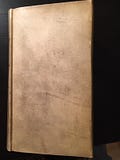Aldus Manutius joins my library
I have recently bid on Ebay for a 1515 Aldine of Aulus Gellius' Noctes Atticarum which I have now won. The book arrived today, and to say it's pretty would be an understatement.
Aldus' printer's mark showing the famous anchor and dolphin
The colophon on the last page, which illustrates the close link between these early printed editions and the manuscript…
Keep reading with a 7-day free trial
Subscribe to Biblonia to keep reading this post and get 7 days of free access to the full post archives.

